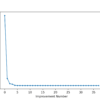Integral calculus was one of the greatest discoveries of Newton and Leibniz. Their work independently led to the proof, and recognition of the importance of the fundamental theorem of calculus, which linked integrals to derivatives. With the discovery of integrals, areas and volumes could thereafter be studied. Integral calculus is the second half of the […]










